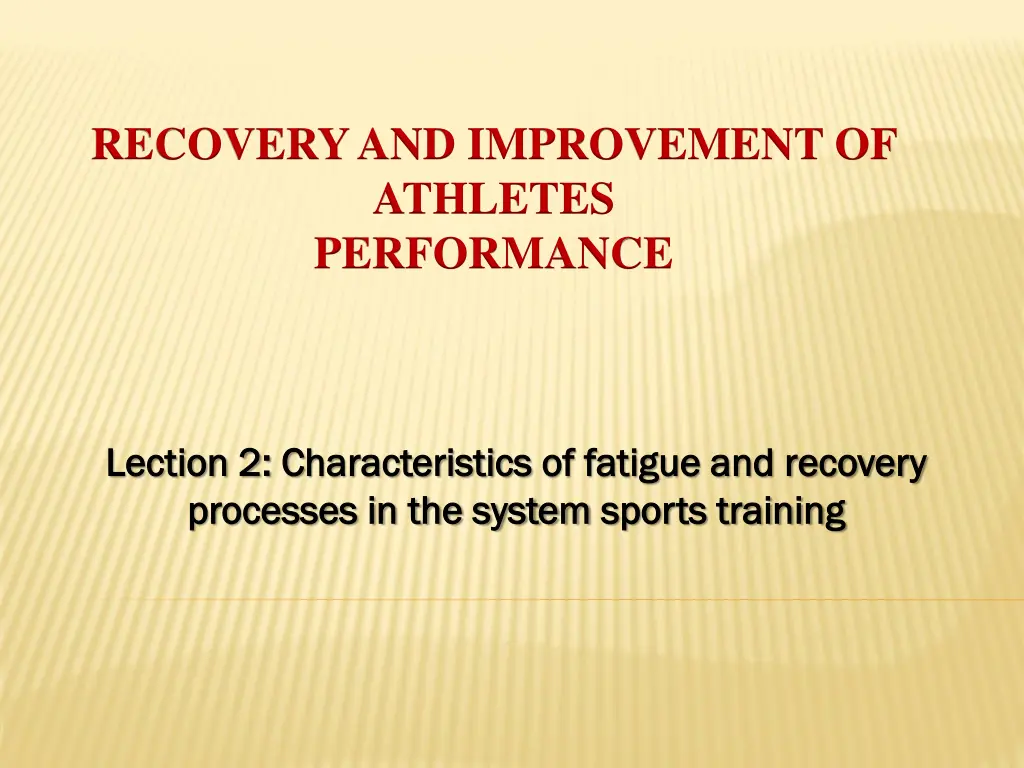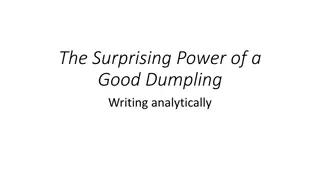
Understanding Fatigue and Recovery Processes in Sports Training
Explore the characteristics of fatigue and recovery processes in sports training, essential for optimizing athlete performance and preventing declines due to overwork or overtraining. Learn about the concept of fatigue, its impact on the body, and the importance of proper recovery strategies. Enhance the fitness and performance of athletes by understanding the physiological aspects of fatigue as a natural phenomenon resulting from intensive work. Dive into the mechanisms of fatigue, its effects on muscle strength, coordination, and energy reserves, ultimately influencing athletic performance.
Download Presentation

Please find below an Image/Link to download the presentation.
The content on the website is provided AS IS for your information and personal use only. It may not be sold, licensed, or shared on other websites without obtaining consent from the author. If you encounter any issues during the download, it is possible that the publisher has removed the file from their server.
You are allowed to download the files provided on this website for personal or commercial use, subject to the condition that they are used lawfully. All files are the property of their respective owners.
The content on the website is provided AS IS for your information and personal use only. It may not be sold, licensed, or shared on other websites without obtaining consent from the author.
E N D
Presentation Transcript
RECOVERY AND IMPROVEMENT OF ATHLETES PERFORMANCE Lection 2 Lection 2: : haracteristics haracteristics of fatigue and recovery processes in the system processes in the system sports training of fatigue and recovery sports training
Recovery of athletic performance and normal function of the body competitive loads is an integral part of the training system after training and The recovery is the physiological basis for long-term adaptation of the body to physical loads. optimal combination of fatigue and
improving improving the fitness of the fitness of athletes improving improving the athlete's the athlete's performance athletes performance As Well As Well As of fatigue- -induced changes in the induced changes in the body development of of overwork overwork development development of of overtraining overtraining stopping stopping the growth of sports the growth of sports results decline decline in the performance of athletes in the performance of athletes As accumulation accumulation of fatigue development body results
WHAT IS MEANT BY THE CONCEPT OF FATIGUE? Fatigue is a special kind of functional state of a person that temporarily appears under the influence of extended or intensive work and leads to a decrease in its effectiveness. Fatigue appears in a decrease in muscle strength and endurance, worsening coordination of movements, an increase in energy costs when performing the same work, slowing down reactions and speed of information processing, difficulty in the process of concentration and switching attention
FATIGUE AS A NATURAL PHYSIOLOGICAL PHENOMENON AND THE RESULT OF THE PERFORMED WORK IS CHARACTERIZED BY the the appearance of a feeling of appearance of a feeling of fatigue temporary changes in temporary changes in metabolism metabolism temporary changes in the regulation of the temporary changes in the regulation of the body (Homeostasis) body (Homeostasis) reduction of the body's energy reduction of the body's energy reserves worsening of the reaction to the worsening of the reaction to the load decrease in general and athletic performance decrease in general and athletic performance fatigue reserves load
BRIEF CONCLUSION Fatigue in sports training should be considered as a natural physiological accompanying almost any load. There is no training without fatigue. It is only important that the level of fatigue matches the performed work phenomenon
SPECIALISTS TAKE INTO ACCOUNT SUCH CONCEPTS OF FATIGUE AS The localization of fatigue The mechanism of fatigue
THE CHARACTER OF THE PERFORMED WORK ARE THE CHARACTER OF THE PERFORMED WORK ARE DETERMINED THE FOLLOWING FACTORS DETERMINED THE FOLLOWING FACTORS Mode Mode of muscle of muscle activity concentric, eccentric) concentric, eccentric) Amount Amount of muscle mass involved in the of muscle mass involved in the exercise (local, regional, global muscle exercise (local, regional, global muscle work) Intensity Intensity and duration of muscle work (aerobic, and duration of muscle work (aerobic, anaerobic and combined modes of muscle anaerobic and combined modes of muscle work work) ) Motivation Motivation level, environmental factors level, environmental factors activity (isometric, isometric, isotonic isotonic, , work)
To To localize localize fatigue, leading leading system system in in which determine determine the the beginning fatigue, it it is is important which functional beginning of of fatigue important to to identify functional changes fatigue identify the changes the Regulatory Regulatory systems systems of of the the body body The The system system of of vegetative muscular muscular activity activity vegetative support support of of The The locomotor locomotor system system
BRIEF CONCLUSION The localization of fatigue is understood as those functional changes in the activity of the leading systems that cause the fatigue
ANOTHER BRIEF CONCLUSION The The another another systems that cause the fatigue systems that cause the fatigue Vegetative Vegetative system system Endocrine Endocrine glands glands
In the process of fatigue development, there is a hidden (overcome) fatigue, in which high performance supported by will effort is kept, In In this case this case The efficiency of motor activity falls, the work is performed with high energy costs
CLASSIFICATION OF CLINICAL SYMPTOMS OF FATIGUE Types Types Manifestation of Manifestation of fatigue fatigue Slight fatigue after after a a small small amount amount and and intensity intensity of of muscle muscle work work Athlete's condition Athlete's condition A A condition condition that that develops develops even even It It appears appears in in the Performance Performance in in this a a rule, rule, does does not the form form of of tiredness this form form of of fatigue, not decrease decrease tiredness. . fatigue, as as Acute Acute fatigue fatigue A condition that develops with A condition that develops with extreme single physical activity extreme single physical activity In In this this condition, condition, weakness performance performance abruptly abruptly decrease, decrease, reactions reactions of of the the cardiovascular to to functional functional tests tests. . Pallor observed observed. . Tachycardia Tachycardia. . An maximum maximum blood blood pressure mm mm Hg, Hg, a a abrupt abrupt decrease blood blood pressure, pressure, an the the metabolic metabolic processes processes of of the an an increase increase in in total total leukocytosis blood blood weakness is is noted, and and muscle muscle appear appear atypical cardiovascular system Pallor of of the An increase pressure by decrease in in minimum an ECG ECG disruption disruption of of noted, strength strength atypical system the face face is is increase in in by 40 40- -60 minimum 60 the heart, heart, leukocytosis of of the the
CLASSIFICATION OF CLINICAL SYMPTOMS OF FATIGUE Types Types Manifestation of Manifestation of fatigue fatigue Athlete's condition Athlete's condition An An condition condition after a a single single maximum maximum training or or competitive competitive load the the background background reduced reduced functional functional state the the body body acutely acutely developing developing performing training load against against of of state of of Common Common sometimes sometimes coordination coordination palpitations, palpitations, pressure pressure. . Cardiac enlargement enlargement of of the hepatic hepatic syndrome), syndrome), atypical of of the the cardiovascular cardiovascular system stress stress. . This This form form of of fatigue fatigue continues a a few few days days to to several several weeks weakness, weakness, fainting, fainting, of of movements movements changes changes Cardiac arrhythmia, arrhythmia, the liver atypical reaction vertigo, vertigo, impaired impaired after performing and and blood blood in in The The overstrain overstrain a a liver (painful (painful reaction system to to continues from weeks from
CLASSIFICATION OF CLINICAL SYMPTOMS OF FATIGUE Types Types Manifestation of Manifestation of fatigue fatigue Athlete's condition Athlete's condition A A develops develops athletes athletes incorrectly incorrectly structured structured training and and rest rest regime regime condition condition that that in in an an Marked Marked changes, changes, athletic athletic violation violation cardiovascular cardiovascular and systems, systems, resistance resistance of of the infections infections neuropsychiatric neuropsychiatric worsening worsening performance, performance, of of and nervous decreased decreased the body body to to of of with with The The overtraining overtraining the the training nervous
CLASSIFICATION OF CLINICAL SYMPTOMS OF FATIGUE Types Types Manifestation of Manifestation of fatigue fatigue The The pathological pathological state of of the the body body. . It It most often often appears appears in in the form form of of observed observed as as a a rule athletes athletes unstable unstable system, system, impressionable, impressionable, excessive excessive physical physical loads Athlete's condition Athlete's condition state most the Athletes Athletes they they are the the results results of of participation in in competitions, competitions, they disturbed disturbed sleep, sleep, there pains pains in in digestive digestive disorders disorders tremor tremor of of the the fingers are are not interested interested in in participation they have there are the the apathetic, apathetic, are not The The overwork overwork neurosis, neurosis, rule in in with with nervous nervous emotionally emotionally have are heart, heart, and and an an fingers. . with with loads
THE MEANING OF FATIGUE IN THE TRAINING PROCESS In the modern system of sports training, fatigue plays a mostly positive role, because its development and compensation are necessary conditions for increasing the functional capabilities of the body, a kind of stress syndrome that should be widely used in various sports to stimulate adaptive shifts in the athlete's body. Intense and long-term physical activity is necessarily followed by one or another degree of fatigue, which in turn causes recovery processes, stimulates adaptive changes in the body The ratio of fatigue and recovery is the physiological basis of the process of sports training.
WHAT IS RECOVERY? Recovery is a process that goes on as a reaction to fatigue and is aimed at restoring homeostasis and working capacity Fatigue and recovery are generalized processes that cover all levels of the body's activity its structural, metabolic, functional components
THE SPEED OF RECOVERY, AS WELL AS THE THE SPEED OF RECOVERY, AS WELL AS THE DEPTH OF FATIGUE ARE DUE TO A COMBINATION DEPTH OF FATIGUE ARE DUE TO A COMBINATION OF THREE MAIN GROUPS OF OF THREE MAIN GROUPS OF FACTORS FACTORS T The he performed performed work work The The state of preparedness of the athlete state of preparedness of the athlete The environmental conditions The environmental conditions
TYPES OF RECOVERY PROCESSES I Immediate recovery mmediate recovery Delayed recovery Delayed recovery
IMMEDIATE RECOVERY I Immediate mmediate recovery hours hours of of rest rest after It It comes comes down decomposition decomposition products the the exercise exercise and debt debt recovery extends after work work down to to eliminating eliminating the products accumulated and paying paying the extends to to the the first first 0 0. .5 5- -1 1. .5 5 the anaerobic anaerobic accumulated during the resulting resulting oxygen during oxygen
DELAYED RECOVERY Delayed Delayed recovery after after work work. . It It consists of of plastic plastic metabolism ionic ionic and and endocrine disturbed disturbed while while exercising In In the the period period of of delayed the the norm norm of of the completed completed recovery extends consists in in the metabolism and endocrine balance exercising delayed recovery, the body's body's energy extends to to many the growing and restoration balance in in the many hours growing processes processes restoration of of the the body hours of of rest rest the body recovery, the energy reserves the return return to to reserves is is
BRIEF CONCLUSION A characteristic feature of the process of recovery after training and competitive loads is the non-simultaneous (heterochronous) return of various indicators to the initial level after the completed training load It was found that after performing training exercises long for 30 seconds with an intensity of 90% of the maximum, recovery of working capacity usually occurs within 90-120 seconds.
THE TIME NEEDED TO COMPLETE THE RECOVERY OF VARIOUS BIOCHEMICAL PROCESSES DURING THE REST PERIOD AFTER HARD MUSCLE WORK Processes in the body Processes in the body Recovery of oxygen reserves in the body Recovery of oxygen reserves in the body Recovery of the Recovery of the alactic alactic anaerobic reserves in anaerobic reserves in muscles muscles Recovery time Recovery time 10 10- -15 15 sec 2 2 5 min 5 min sec Pay Pay back back of Removal of lactic acid from the body Removal of lactic acid from the body Pay Pay back back of lactic oxygen debt of lactic oxygen debt Resynthesis Resynthesis of intramuscular glycogen reserves of intramuscular glycogen reserves Recovery of glycogen reserves in the liver Recovery of glycogen reserves in the liver Increasing the synthesis of enzyme and Increasing the synthesis of enzyme and structural proteins structural proteins of alactic alactic oxygen debt oxygen debt 3 3 5 min 5 min 1 1 1,5 hours 1,5 hours 1 1 1,5 hours 1,5 hours 12 12 - - 48 48 hours 12 12 - - 48 48 hours 12 12- -72 hours 72 hours hours hours
Performing Performing hard developing developing fatigue level level, , super super- -recovery the the pre pre- -working working level hard muscle muscle work fatigue, , its its recovery recovery and and further level work is is related recovery to to the the pre further stabilization stabilization at at related to to pre- -working working These These stages athlete's athlete's performance performance. . There decrease decrease in in supercompensation supercompensation and stages also also determine determine the the variations variations in in the There is is a a phase performance performance, , and stabilization stabilization the phase of of recovery recovery, , its its
RECOVERY PHASES phase of of recovery recovery of of working working working level level occurs occurs replenishment replenishment of of energy energy reserves homeostasis homeostasis In In the the phase working capacity normalization normalization reserves and capacity to to the of of and restoration restoration of of the pre functions, functions, pre- - In the phase of In the phase of super energy resources is taking place energy resources is taking place super- -recovery recovery, , supercompensation supercompensation of of In In the the stabilization stabilization phase systems systems are are reconstructed reconstructed phase cellular cellular structures structures and and enzyme enzyme
CHANGES CHANGES IN THAT THAT EMERGE EMERGE DURING FOR FOR IMPROVING IMPROVING PREPAREDNESS IN THE THE FUNCTIONAL FUNCTIONAL SYSTEMS DURING THE THE RECOVERY PREPAREDNESS SYSTEMS OF RECOVERY PERIOD OF THE THE ATHLETE'S ATHLETE'S BODY PERIOD ARE ARE THE BODY BASIS THE BASIS Because Because of of this loads loads two two phases The The phase under under the period) period) which of of the the body The The constructive constructive phase during during which which the structural structural changes summation summation of of trace this when phases should phase of of changed the influence influence of of muscle which is is based based on body; ; its its calculated calculated in in minutes phase (the the is is the changes in in organs trace reactions reactions to to loads when analyzing analyzing after should be be recognized recognized: : changed somatic after the the working working period period after after somatic and muscle work on the the restoration restoration of of homeostasis minutes and and hours (the period period of of delayed delayed recovery), the formation formation of of functional organs and and tissues tissues due loads and vegetative vegetative functions work (early (early recovery homeostasis hours functions recovery 1) 1) recovery), 2) 2) functional and due to to the and the
V.A. V.A. ENGELGARTD'S ENGELGARTD'S RULE RULE The intensity of the process of recovery and the time of replenishment of the body's energy reserves depend on the intensity spending during the exercise of their The intensification of recovery processes leads to the fact that at a certain moment of rest after work, the reserves of energy means exceed their pre- working level. This supercompensation, or super-recovery phenomenon is called
Duration of the supercompensation phase in time depends on the total duration of the work and the depth of the biochemical changes caused by physical work in the body The heterochronic in nature. For example, after loads aimed at developing endurance, first of all, the reserves of phosphagens in the muscles and the concentration of glucose in the blood are restored, and last of all, the reserves of glycogen in the muscles and liver formation of supercompensation is also
CONCLUSION Supercompensation Supercompensation is is a a reaction a a rather rather deep deep exhaustion exhaustion of of the the the athlete's athlete's body body that specific specific work work The The higher higher the the qualification athletes, athletes, the the supercompensation supercompensation phase fatigue fatigue of of athletes, athletes, exhaustion structures structures of of their their body In In well well- -trained trained highly maximum maximum loads loads of of training 3 3 sessions sessions during during the supercompensation supercompensation reaction to to loads the functional functional reserves that provide provide for for the the performance loads that that lead reserves of of performance of of lead to to qualification and more more phase depends exhaustion of of the body highly qualified qualified athletes, training sessions sessions or or their the day) day) can can lead and preparedness preparedness of of severity severity depends on on the the functional the the of of depth of of functional the the the depth athletes, only their series lead to to a a phase only the series ( (2 2- - phase of of the
SOME CONCEPTS FROM THE LECTURE Fatigue Fatigue is is a a special that that temporarily temporarily appears or or intensive intensive work effectiveness effectiveness Fatigue Fatigue can can result sustained sustained muscle muscle use the the athlete athlete cannot The The most most common common non athlete athlete are are inappropriate stressors, stressors, suboptimal suboptimal hydration special kind appears under work and and leads kind of of functional functional state under the the influence leads to to a a decrease state of of a a person influence of of extended decrease in in its person extended its result due use over cannot continue, continue, has non- -medical inappropriate training inadequate inadequate hydration due to to depleted depleted energy over a a longer longer time has nothing nothing left medical causes causes of of tiredness training plan, plan, poor macronutrient macronutrient energy along time. . This This feels left in in the tiredness in in the poor sleep, sleep, lifestyle intake intake along with feels like the tank tank with like the lifestyle and and
OXYGEN DEBT Oxygen Oxygen debt available available develops develops during activity activity and returns returns to to rest debt is is a a cumulative cumulative deficit for for oxidative oxidative during periods periods of of intense and must must be be made made good rest deficit of of oxygen metabolism metabolism intense bodily good when when the oxygen that that bodily the body body
Oxygen debt occurs when the body reaches a state of anaerobic respiration during intense exercise. When a person engages in high levels of physical activity, the body cannot distribute oxygen to the cells at a sufficiently rapid pace to keep up with the oxygen demand. This results in an oxygen deficit as the cells continue to produce energy but need additional oxygen to process the lactic acid produced during the process
ANAEROBIC RESPIRATION Oxygen Oxygen is is used using using a a process process called intensive intensive exercise, exercise, the enough enough oxygen oxygen to to the referred referred to to as as an reaches reaches a a state state of of oxygen energy energy is is produced produced using used by by the called aerobic aerobic respiration the body body cannot the muscle muscle cells an oxygen oxygen deficit deficit. . Once oxygen deficit deficit during using anaerobic anaerobic respiration the cells cells to to produce respiration. . During cannot deliver cells. . This Once the during exercise, produce energy energy During deliver status is is the body body exercise, This status respiration
ANAEROBIC RESPIRATION Anaerobic Anaerobic respiration energy energy that that the process process creates creates a a waste acid acid. . During During aerobic further further broken broken down water water. . Oxygen Oxygen is is needed place place respiration breaks the cells cells can waste substance aerobic respiration, respiration, this down into into carbon needed for breaks down can use use to to function substance called this lactic carbon dioxide for this this step down glucose glucose into function. . The called lactic lactic acid dioxide and step to to take into The lactic acid is is and take
ANAEROBIC RESPIRATION When When the complete complete eliminate eliminate the debt debt. . After After an or or she she will this this oxygen oxygen debt, built built up up lactic lactic acid the body body lacks the the the lactic lactic acid, an individual's individual's activity will take take in in extra extra oxygen debt, allowing allowing the acid lacks the process process acid, it it is is said the necessary necessary oxygen of of respiration respiration said to to be activity level level slows, oxygen to to gradually gradually repay the cells cells to to process oxygen to to and and be in in oxygen oxygen slows, he he repay the process the
AEROBIC AND ANAEROBIC EXERCISES Aerobic Aerobic exercise exercise is is any any type conditioning conditioning or or cardio cardio. . During conditioning, conditioning, your your breathing breathing increase increase for for a a sustained sustained period of of aerobic aerobic exercise exercise running, running, or or cycling cycling. . Anaerobic Anaerobic exercises exercises involve involve quick and and are are performed performed at at maximum time time. . Examples Examples include include jumping, heavy heavy weight weight lifting lifting. . type of of cardiovascular cardiovascular During cardiovascular cardiovascular and and period of of time time. . Examples include include swimming swimming heart heart Examples rate rate laps, laps, quick bursts bursts of of energy maximum effort effort for jumping, sprinting, energy short for a a short sprinting, or or
AEROBIC AND ANAEROBIC EXERCISES Your respiration and heart rate differ in aerobic activities versus anaerobic ones. Oxygen is your main energy source during aerobic workouts. During aerobic exercise, you breathe faster and deeper than when your heart rate is at rest. You re maximizing the amount of oxygen in the blood. Your heart rate goes up, increasing blood flow to the muscles and back to the lungs. During anaerobic exercise, your body requires immediate energy. Your body relies on stored energy sources, rather than oxygen, to fuel itself. That includes breaking down glucose.
WHY DOES IT TAKE MORE OXYGEN TO RECOVER? You You needed needed to to replace needed needed but but couldn t couldn t get Breathing Breathing rate rate and remove remove CO CO2 2) ) and Body Body temperature temperature and increased increased and and this Adrenaline Adrenaline and which which increases increases oxygen replace the get (oxygen (oxygen deficit and heart heart rate and this this needs needs more and the the metabolic this needs needs more more oxygen and Noradrenaline Noradrenaline are oxygen consumption consumption the oxygen oxygen the deficit) ) rate are are elevated more oxygen oxygen metabolic rate oxygen are increased the body body elevated (to (to rate are are increased
The The chart chart above oxygen oxygen used used by the the beginning, beginning, the leaving leaving an an oxygen consumption consumption levels exercise exercise, , the the oxygen above is is shows by the the body the body oxygen deficit deficit. . Over levels out out to to a a steady oxygen is is paid paid back shows how body change change over body works works anaerobically Over time time the steady- -state back ( (oxygen how the the amount amount of of over time time. . In In anaerobically the oxygen state. . After oxygen debt oxygen After debt) )
WHAT HAS LACTIC ACID GOT TO DO WITH WHAT HAS LACTIC ACID GOT TO DO WITH OXYGEN DEBT? OXYGEN DEBT? Lactic acid is a by-product of exercising without using oxygen (anaerobically). It is essential this is removed but it is not necessarily a waste product. It is recycled into other useful chemicals. During prolonged intensive exercise the heart may get half its energy from lactic acid. It is converted back to pyruvic acid and used as energy by the heart and other muscles. It is thought that 70% of lactic acid produced is oxidized, 20% is converted to glucose (energy) in the liver. 10% is converted to protein.






















